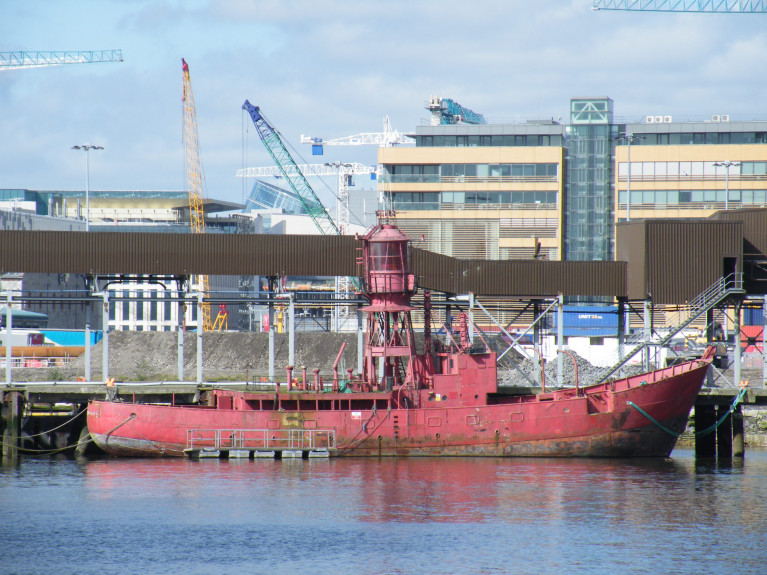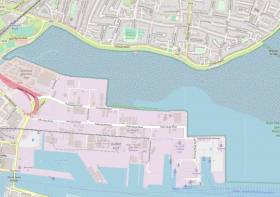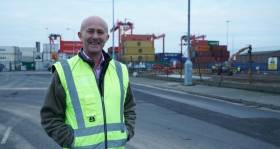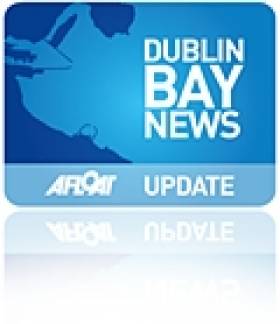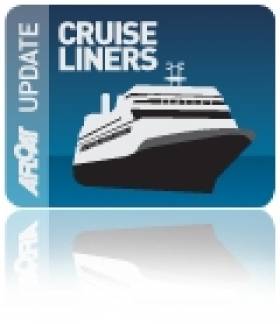Displaying items by tag: Harry Crosbie
Dublin 'Docklands' Developer Harry Crosbie Seeks Return of former Lightship ‘Kittiwake’
The Dublin 'docklands' developer, Harry Crosbie is launching a campaign for the return of the 134ft (floating) landmark, Kittiwake.
The former lightship which he (had berthed) alongside the Liffey and (opposite) of The Point Depot, now the O2, then one of his many docklands business ventures.
But the distinctive red ship, which was sold to him by its owners, the Commissioners of Irish Lights (CIL), for a reputed €60,000, is now in the possession of Dublin Port, which has docked it away from public view in Alexandra Basin within the port complex.
For more on this development of the former lightship, Independent.ie reports here.
As Afloat previously reported, it is almost a decade since Crosbie's plans to relocate the former lightship Kittiwake on the North Quay Wall, in front of the O2 Theatre, were refused permission.
The 1959 built lightship was converted in the 1980's by Irish Lights into an Automated Light-Float (ALF) and last served on station at South Rock off the Co. Down coast until 2005.
ALF Kittiwake was the second last lightship to operate in waters around Ireland.
Reclaim Land From Sea At Clontarf To Tackle Housing Crisis, Suggests Docklands Developer
Clontarf residents will likely be wide-eyed at a recent “radical” proposal by Docklands developer Harry Crosbie to reclaim land from the sea off the North Dublin suburb.
According to The Irish Times, the property mogul suggests using Dutch engineering knowhow to reclaim some 250 acres between the existing Docklands and Clontarf Road, which currently lie within the River Tokla Estuary Special Protection Area, that could be repurposed for homes for 65,000 people and help tackle the housing crisis.
Crosbie — whose former warehouse on Tolka Quay Road was recently licensed by the State for post-Brexit freight checks — admitted to Marian Finucane on RTÉ Radio 1 on Saturday (17 August) that his plan was “radical” but that the people of Clontarf would come to see it make the area “a nicer place to live in over a period of 10 years”.
He also shot down similar recent proposals by Royal Institute of the Architects of Ireland president David Browne to reclaim land off Sandymount Strand, on the opposite side of Dublin Bay, as “a bridge too far”.
The Irish Times has more on the story HERE.
Former Crosbie Property at Dublin Port Taken Over by State for Post-Brexit Checks
#dublinport - At Dublin Port freight requiring physical checks after Brexit will, writes The Irish Times, be inspected in a warehouse formerly owned by businessman Harry Crosbie following an agreement signed by the State.
As part of contingency planning for the United Kingdom crashing out of the European Union without a deal next month, Dublin Port Company has signed a licensing agreement with the Office of Public Works to hand over use of a port-owned 13,000m warehouse on a five-acre site at the northeastern part of the port for Brexit-related checks.
The departure of the UK, the State’s closest trading partner, from the EU will lead to a huge increase in the number of UK imports requiring customs, health and safety clearance on their arrival into the port.
Eamonn O’Reilly, the port’s chief executive, confirmed it had licensed the property on Tolka Quay Road to the State, and that the OPW was fitting out the former Crosbie warehouse property and another seven-acre inspection area to be ready for Brexit-related checks after the UK’s departure on March 29th.
For more on this development, click here.
Dublin Port Outlines Plans for First Dedicated Cruise Terminal
In order to facilitate this growth, the draft proposes switching existing berths used by large cruiseships away from unattractive cargo-docks in Alexandra Basin's West and East and at Ocean Pier. Up to three alternative locations were examined and the port agreed that the option identified in the Dublin City Council's Area Plan of the North Quay Extension is the optimum location.
Before any such development, it would require relocating an existing roll-on roll-off terminal (No.3), which is currently in use by P&O Irish Sea for their Dublin-Liverpool service. The company operate three sailings daily on the central corridor route.
The new facility could accommodate two large cruise ships simultaneously and would be much larger than the 43,524grt The World, the luxury resort vessel operated by Residensea, which docked at the North Wall Extension in 2010 (for report click HERE).
The location is on the doorstep to the East-Link Bridge and the neighbouring O2 Arena and Point Village developed by Harry Crosbie, who called for the relocation of cruise callers to be sited upriver.
According to the draft, the closer proximity to the city-centre would provide a stronger presence and a more accessible link with the city. It would also avoid the unnecessary longer bus transfers between cruise berths and visitor attractions in the city-centre and locations in counties Wicklow and Meath.
Construction of facilities for a cruise terminal would expensive as it will involve new quay walls capable of accepting large cruise vessels but this could only be done after dredging the channel to a depth of 10.5m.
The facilities of the terminal are to incorporate a reception, tourist information and interpretive centre, a dedicated entrance for pedestrians, coaches, vehicles and traffic management measures would be implemented.
In addition the site would also require the expensive exercise in re-locating ESB underwater high-voltage cables. The initial costs suggest to develop new terminal facilities and associated works would be in the region of €30m.
Dublin Port Company, state that due to the relatively low revenues generated by cruise ships, such an investment alone could not be justified, however, they could part-fund the development but additional funding would be required from other sources.
- Dublin Port
- Dublin Port Company
- The World
- Cruise Liners
- Harry Crosbie
- Port of Dublin
- Ports and Shipping News
- Point Village
- P&O (Irish Sea)
- Cruise Liner news
- Ocean Pier Dublin Port
- O2 Arena
- EastLink bridge
- Dublin Port draft masterplan
- DPC
- North Wall Quay Extension
- Residensea
- Dublin Port Terminal 3
- Alexandra Basin Dublin
Crosbie’s Café Lightship Plan Rejected
Dublin City Council told Crosbie that consent for the use of the campshires for the bar had not been agreed to by the board of the Dublin Dockland Development Authority (DDDA), which owns the quays, "and that said permission will not be forthcoming".
Crosbie had received a letter from the then chief executive officer of the DDDA Paul Maloney in December 2008 saying that the authority was willing to let the development go ahead, subject to consent from the authority's executive board.
This permission will not know be forthcoming but the authority does feel that the ship should be used as a bar on the Liffey itself rather than on the campshires.
The Kittiwake has laid idle since 2007 when the vessel was purchased from the Commissioners of Irish Lights. She was the second last lightship to serve in Irish waters. During the 1980's she and several other lightships were converted from manned operation into automatic light-floats or ALF's. To read more about the last Irish lightship ALF Gannet click HERE.
Lightship To Lead A Rocky Life?
The Dublin 'Docklands' developer, Harry Crosbie is seeking permission from Dublin City Council to raise the 500-ton lightship, Kittiwake and place on the quayside opposite The 02 Theatre. Currently the lightship is berthed nearby the East-Link road toll bridge and acts as a notable floating feature to countless daily commuters.
In 2007, the Commissioners of Irish Lights (CIL) sold the 1959 built lightship to Crosbie. The 134-foot lightship had served in that role for many years around the Irish coast. In 1981, as part of an extensive modernisation programme, the Kittiwake and other lightships were converted into an automated light-float (ALF). The last station served by the ALF was at South Rock, Co. Down.
If the former lightship is given the green light, the vessel would act as a "welcoming point" for cruise tourists. Subject to planning permission, the lightship would undergo another re-conversion project to create an open-plan café bar for a period of five years.
The veteran vessel would also have its lighthouse light restored and would "beam" across the docklands and entertainment venue. The lightship would maintain its customary 'red' hull with Kittiwake written in neon on the side.
In order to attract this cruise business to the Kittiwake, Crosbie has asked the Dublin Port Company to relocate the main existing cruise-ship location closer to the O2 Theatre. The proposal has the support of Dublin City Council.
In the meantime the majority of cruise-ships dock at Alexandra Basin, in the heart of the port's industrial zone but the distance is quite far from there to the city centre.
On an annual the capital welcomes around 80,000 passengers during each season, generally between May to October. In 2011, the port expects 86 cruise-calls, potentially generating €35m to €55m to the economy.
The proposed for the new terminal is to be submitted to the EU this month, in the hope of financing support. Meanwhile the proposed site envisaged for the cruise terminal, is occupied by tugs based operated by Dublin Port Company.
Proposal to Move Cruise Ship Terminal on the Liffey
According to a report in the Irish Times this morning Dublin Port Company is considering a proposal by docklands entrepreneur Harry Crosbie to relocate the city's cruise ship terminal to a site closer to the heart of the city beside the East Link bridge. 86 Cruise liners arrived in Dublin Port this Summer.
Cruise liner traffic into Dublin is in line with last years figures when almost 80 cruise liners visited the port in 2009, carrying 120,000 passengers and crew to Dublin.
The largest arrival the blue hulled Marco Polo at 176 metre contribute significantly to the Dublin economy.


























